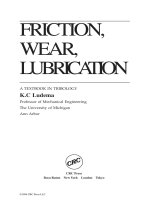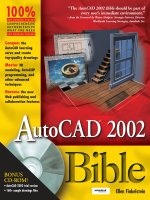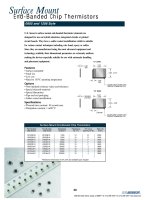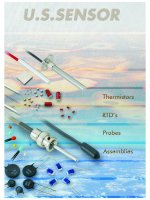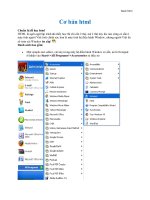Tài liệu U.S.Sensor P1 doc
Bạn đang xem bản rút gọn của tài liệu. Xem và tải ngay bản đầy đủ của tài liệu tại đây (2.95 MB, 20 trang )
Page
Mission Statement..................................................................................2
Company Overview ...............................................................................3
General Information...........................................................................4-5
Thermistor Markets and Applications ................................................6-7
Terminology........................................................................................8-9
Ultra Precision Interchangeable Thermistors .......................................10
Standard Precision Interchangeable Thermistors..................................11
Precision Interchangeable Thermistors.................................................12
DO-35 Standard Glass Encapsulated Thermistors...............................13
DO-35 Interchangeable Glass Encapsulated Thermistors....................14
DO-41 Standard Glass Encapsulated Thermistors...............................15
Standard Leaded Epoxy Coated Thermistors.......................................16
Miniature Leaded Epoxy Coated Thermistors .....................................17
“MELF” Style LL-34 Thermistors .......................................................18
“MELF” Style LL-31/LL-41 Thermistors............................................19
Surface Mount End-Banded Chip Thermistors ...................................20
Leadless Chip Thermistors...................................................................21
Inrush Current Limiting Power Thermistors .......................................22
Thin Film Platinum RTD’s..................................................................23
Calibrated Thermistor Probes ..............................................................24
Thermistor and RTD Probe Assemblies .........................................25-38
Precision Interchangeable Thermistor Tables..................................40-43
Resistance-Temperature Conversion Tables ....................................44-45
1832 West Collins Avenue, Orange, CA 92867 • Tel. (714) 639-1000 • Fax (714) 639-1220 • www.ussensor.com
Table of Contents
2
O
ur mission is “Total Quality Commitment” by continuing to build:
A partnership with our employees by promoting team effort, communication
and empowering them to do their best, and by creating an outstanding work
environment through innovative SPC concepts and methods which, by our company’s
success, fosters self-advancement.
A partnership with our customers and sales representatives by providing
expert engineering and sales support as well as on-time delivery of thermistors,
probes and assemblies which exceed their quality and performance requirements.
A partnership with our vendors by clearly communicating our high
expectations of service and product quality thereby insuring our ability to provide
the same to our customers.
A partnership with our community by providing employment opportunities
and by being responsive to important civic issues.
“Our goal is to be the best thermistor manufacturer in the world with a strong
commitment to meeting or exceeding customer requirements, and continually
improving the effectiveness of the quality management system.
–U.S. Sensor Corp.
Mission Statement
U.S. Sensor Corp.
U.S. Sensor is a world class manufacturer of an extensive variety of the highest quality
thermistors as well as thermistor probes and assemblies. The company’s products include
NTC and PTC thermistors which are produced using proprietary state of the art processing
techniques. Customers worldwide use U.S. Sensor thermistors in their most demanding
applications.
Leading Edge Technology
To assure that U.S. Sensor maintains its competitive position in the marketplace and contin-
ues to provide products which exceed its customers specified requirements, the company
continues to make substantial investments in the most advanced component manufacturing
equipment as well as in research and development of innovative products and manufacturing
processes.
Products Designed From The Ground Up
U.S. Sensor manufactures thermistors by preparing precise formu-
lations of powdered transition metal oxides “doped” with stabiliz-
ing agents. These compounds are combined with binder materials
and processed using proprietary techniques resulting in superior
quality components and assemblies.
Application Engineering
U.S. Sensor’s application engineering personnel are highly trained professionals who will assist
you to select a standard thermistor or RTD, or design a special device for your
most exacting requirement. Whether your application requires a simple compo-
nent, a probe assembly or a complex network which will exhibit non-standard
resistance temperature characteristics particularly suited to your requirements, our
application engineering personnel will be most helpful. U.S. Sensor personnel
have been designing unique devices for the most demanding applications for
more than thirty years.
Quality
SPC (statistical process control) techniques are used throughout the manufacturing
processes in an endless loop of quality improvement. Total Quality Management is our
pledge.
Company Overview
3
1832 West Collins Avenue, Orange, CA 92867 • Tel. (714) 639-1000 • Fax (714) 639-1220 • www.ussensor.com
4
NTC and PTC Thermistors
Definition
Thermistors are thermally sensitive resistors whose prime function is to exhibit a large,
predictable and precise change in electrical resistance when subjected to a corresponding change
in body temperature. Negative Temperature Coefficient (NTC) thermistors exhibit a decrease in
electrical resistance when subjected to an increase in body temperature and Positive Temperature
Coefficient (PTC) thermistors exhibit an increase in electrical resistance when subjected to an
increase in body temperature. U.S. Sensor produces thermistors capable of operating over the
temperature range of -100˚ to over +600˚F. Because of their very predictable characteristics and
their excellent long term stability, thermistors are generally accepted to be the most advantageous
sensor for many applications including temperature measurement and control.
Since the negative temperature coefficient of silver sulphide was first observed by Michael
Faraday in 1833, there has been a continual improvement in thermistor technology. The most
important characteristic of a thermistor is, without question, its extremely high temperature
coefficient of resistance. Modern thermistor technology results in the production of devices with
extremely precise resistance versus temperature characteristics, making them the most
advantageous sensor for a wide variety of applications.
A thermistor’s change in electrical resistance due to a corresponding temperature change is evident
whether the thermistor’s body temperature is changed as a result of conduction or radiation from
the surrounding environment or due to “self heating” brought about by power dissipation within
the device.
When a thermistor is used in a circuit where the power dissipated within the device is not
sufficient to cause “self heating”, the thermistor’s body temperature will follow that of the
environment. Thermistors are not “self heated” for use in applications such as temperature
measurement, temperature control or temperature compensation.
When a thermistor is used in a circuit where the power dissipated within the device is sufficient
to cause “self heating”, the thermistor’s body temperature will be dependent upon the thermal
conductivity of its environment as well as its temperature. Thermistors are “self heated” for use in
applications such as liquid level detection, air flow detection and thermal conductivity measurement.
Manufacturing Processes
U.S. Sensor manufactures thermistors using sophisticated state of the art processing techniques.
Their excellent long term stability coupled with precision interchangeability and low cost makes
them ideally suited for temperature sensing applications. The devices are available in a wide
variety of styles designed to suit countless circuit requirements.
NTC Manufacturing Processes
NTC thermistors are manufactured using homogeneous compounds of various metal oxides
including Manganese, Nickel, Cobalt and Copper. The powdered metal oxides, along with
stabilizing agents and organic binders, are combined into exact formulations which will exhibit
certain electrical characteristics upon completion of the manufacturing processes. Dependent
upon the particular application for which the devices are to be used, the oxide/binder
formulation is formed into any number of shapes including chips, discs, wafers and bars.
General Information
1832 West Collins Avenue, Orange, CA 92867 • Tel. (714) 639-1000 • Fax (714) 639-1220 • www.ussensor.com
5
Chips
Precision interchangeable thermistors used for temperature measurement and
control as well as glass encapsulated and surface mount devices typically
utilize a small chip thermistor sensing element. A slurry, consisting of the
metal oxide compounds and special organic binders, is “cast” onto a flat sur-
face to exacting dimensions. The thickness of the “cast tape” can be as thin as
0.001" or as thick as 0.050" depending upon the application. The “cast tape”
ware is “blanked” into wafers or substrates of a suitable size. The “green”
wafers are sintered at high temperature and electroded with silver or other
electrode materials.
The electroded wafers are diced into the exact size dictated by the particular application. A typical
wafer will yield from 2,000 to 20,000 devices depending upon the size of the chips required.
The chips are tested electrically, lead wires are attached, resistance trimming is performed if neces-
sary and an encapsulant is applied. In some applications the “unleaded” bare chip can be used “as
is”. Chips can also be encapsulated in a hermetically sealed (DO-35 or DO-41) style leaded glass
package or into a “MELF” style surface mount package.
Discs
For production of large disc thermistors as well as power thermistors, those devices used
primarily for inrush current limiting in switching mode power supplies, discs ranging in size
from 0.200" diameter to over 1.000" diameter are formed from the oxide/binder formulation
using a tableting press. Precise quantities of powder are automatically metered into a die cavity
and compacted into a shape which conforms to the specified dimensional characteristics. This
process results in uniform density throughout the device as well as uniform electrical characteris-
tics throughout the production run. The “green” discs are then subjected to a high temperature
sintering process which will result in the device achieving the desired resistance versus tempera-
ture characteristics. The “sintered” discs are then metallized. A thick film silver electrode materi-
al is applied to the “flats” of the discs and fired to allow for subsequent electrical contact to the
device. Testing of the thermistor’s electrical characteristics is performed to confirm that the
devices conform to the desired resistance versus temperature characteristic. Lead wires are
attached using specially formulated solder and an encapsulant of epoxy or silicone resin is usually
applied to the device for environmental protection.
Silicon PTC Manufacturing Processes
Silicon PTC thermistors are manufactured using the positive temperature coefficient of
specially doped single crystal silicon. The ingot is grown and doped to precise specifications
and sliced into thin wafers. An electrode is applied to the flat surfaces of the wafers which are
subsequently diced into small chips. The chips are then sealed in DO-35 (Diode Style) or
LL-34 (Surface Mount) packages and electrically tested to confirm that they meet their
specified resistance temperature characteristics.
Probes And Assemblies
Most of the standard thermistors and RTD’s listed in the U.S. Sensor catalog are available
mounted in special probe housings designed for sensing temperature under the most demand-
ing environmental conditions. U.S. Sensor’s standard probe housings range in size from less
than 0.020" diameter to over 0.375" diameter and are constructed from various materials
including stainless steel, aluminum, epoxy, polyimide and PVC, just to name a few. Detailed
descriptions of some of U.S. Sensor’s standard probe housings are presented in this catalog.
1832 West Collins Avenue, Orange, CA 92867 • Tel. (714) 639-1000 • Fax (714) 639-1220 • www.ussensor.com
Consumer Electronics
Air conditioners
Audio amplifiers
Cellular telephones
Clothes dryers
Computer power supplies
Dishwashers
Electric blanket controls
Electric water heaters
Electronic thermometers
Fire detectors
Home weather stations
Oven temperature controls
Pool and spa controls
Rechargeable battery packs
Refrigerator and freezer temperature controls
Small appliance controls
Solar collector controls
Thermostats
Toasters
Washing machines
Automotive
Audio amplifiers
Automatic climate controls
Coolant sensors
Electric coolant fan temperature controls
Emission controls
Engine block temperature sensors
Engine oil temperature sensors
Intake air temperature sensors
Oil level sensors
Outside air temperature sensors
Transmission oil temperature sensors
Water level sensors
Medical Electronics
Blood analysis equipment
Blood dialysis equipment
Blood oxygenator equipment
Clinical fever thermometers
Esophageal tubes
Infant incubators
Internal body temperature monitors
Internal temperature sensors
Intravenous injection temperature regulators
Myocardial probes
Respiration rate measurement equipment
Skin temperature monitors
Thermodilution catheter probes
Thermistor Markets and Applications
6
1832 West Collins Avenue, Orange, CA 92867 • Tel. (714) 639-1000 • Fax (714) 639-1220 • www.ussensor.com
Industrial Electronics
Commercial vending machines
Crystal ovens
Fluid flow measurement
Gas flow indicators
HVAC equipment
Industrial process controls
Liquid level indicators
Microwave power measurement
Photographic processing equipment
Plastic laminating equipment
Solar energy equipment
Thermal conductivity measurement (diamond testers etc.)
Thermocouple compensation
Thermoplastic molding equipment
Thermostats
Water purification equipment
Welding equipment
Military And Aerospace
Aircraft temperature
Bathythermography
Fire control equipment
Missiles and spacecraft temperature
Oscillator compensation
Physiological monitoring
Satellites
Food Handling And Processing
Coffee makers
Deep fryers
Fast food processing
Perishable shipping
Temperature controlled food storage systems
Thermometers for use in food preparation
Communication And Instrumentation
Amplifier over temperature sensing
Cellular telephones
Copper coil winding temperature compensation
Oscillator temperature compensation
Rechargeable battery packs
Transistor gain stabilization
Transistor temperature compensation
Computer
Power supplies (inrush current limiting)
Uninterruptible power supplies
(over temperature sensing)
7
1832 West Collins Avenue, Orange, CA 92867 • Tel. (714) 639-1000 • Fax (714) 639-1220 • www.ussensor.com


